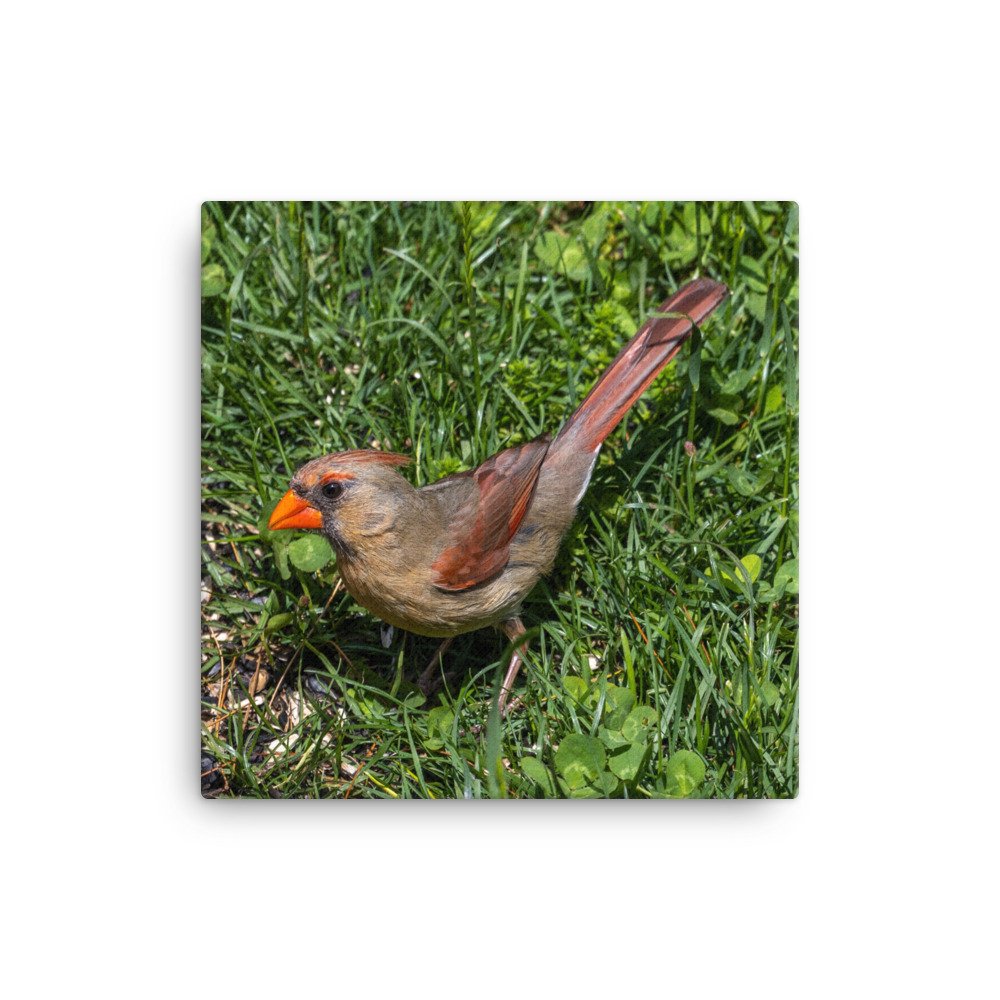 Image 1 of 4
Image 1 of 4

 Image 2 of 4
Image 2 of 4

 Image 3 of 4
Image 3 of 4

 Image 4 of 4
Image 4 of 4





Canvas - Female Northern Cardinal Baby (Cardinalis Cardinalis)
from $40.00
The Female Northern Cardinal can be identified by its pale brown color with warm reddish tinges in the wings and tail and a grey/black mask. Their bill is cone-shaped, coral colored, short and thick to allow them to crush seeds and extract their main source of food. Their beaks have special features that make cracking easier; the edges of the lower beak fit into special grooves in the upper beak. They use their tongue to maneuver seeds into the groove.
Females will normally have from 2-5 eggs and 2-3 broods per year from March to August. Incubation is almost always done by female alone and takes from 12-13 days. Both parents will feed the nestlings and young will leave nest about 9-11 days after hatching. The male may continue to feed fledglings while the female begins her next nesting attempt.
Females will normally have from 2-5 eggs and 2-3 broods per year from March to August. Incubation is almost always done by female alone and takes from 12-13 days. Both parents will feed the nestlings and young will leave nest about 9-11 days after hatching. The male may continue to feed fledglings while the female begins her next nesting attempt.
Size:
Quantity:
Add To Cart
The Female Northern Cardinal can be identified by its pale brown color with warm reddish tinges in the wings and tail and a grey/black mask. Their bill is cone-shaped, coral colored, short and thick to allow them to crush seeds and extract their main source of food. Their beaks have special features that make cracking easier; the edges of the lower beak fit into special grooves in the upper beak. They use their tongue to maneuver seeds into the groove.
Females will normally have from 2-5 eggs and 2-3 broods per year from March to August. Incubation is almost always done by female alone and takes from 12-13 days. Both parents will feed the nestlings and young will leave nest about 9-11 days after hatching. The male may continue to feed fledglings while the female begins her next nesting attempt.
Females will normally have from 2-5 eggs and 2-3 broods per year from March to August. Incubation is almost always done by female alone and takes from 12-13 days. Both parents will feed the nestlings and young will leave nest about 9-11 days after hatching. The male may continue to feed fledglings while the female begins her next nesting attempt.
The Female Northern Cardinal can be identified by its pale brown color with warm reddish tinges in the wings and tail and a grey/black mask. Their bill is cone-shaped, coral colored, short and thick to allow them to crush seeds and extract their main source of food. Their beaks have special features that make cracking easier; the edges of the lower beak fit into special grooves in the upper beak. They use their tongue to maneuver seeds into the groove.
Females will normally have from 2-5 eggs and 2-3 broods per year from March to August. Incubation is almost always done by female alone and takes from 12-13 days. Both parents will feed the nestlings and young will leave nest about 9-11 days after hatching. The male may continue to feed fledglings while the female begins her next nesting attempt.
Females will normally have from 2-5 eggs and 2-3 broods per year from March to August. Incubation is almost always done by female alone and takes from 12-13 days. Both parents will feed the nestlings and young will leave nest about 9-11 days after hatching. The male may continue to feed fledglings while the female begins her next nesting attempt.
